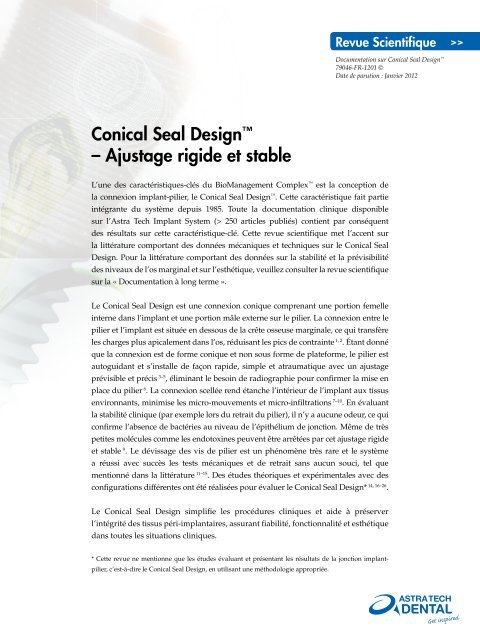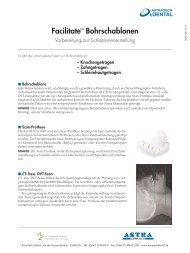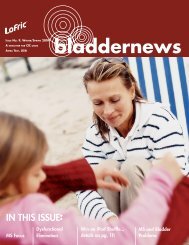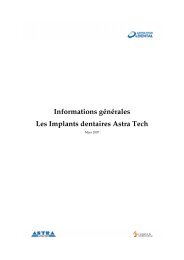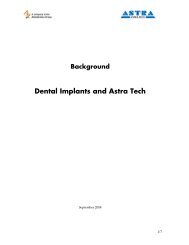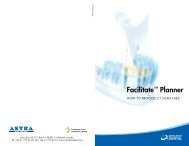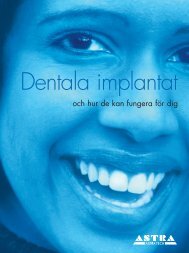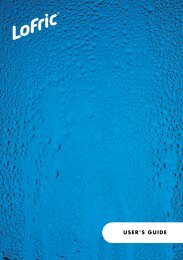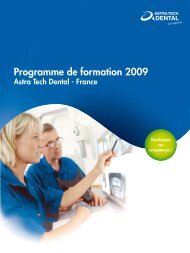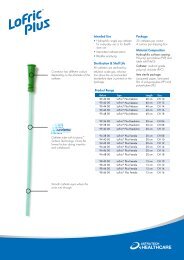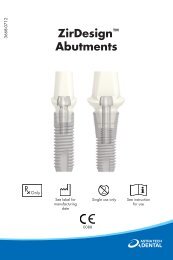Conical Seal Design™ – Ajustage rigide et stable - Astra Tech
Conical Seal Design™ – Ajustage rigide et stable - Astra Tech
Conical Seal Design™ – Ajustage rigide et stable - Astra Tech
Create successful ePaper yourself
Turn your PDF publications into a flip-book with our unique Google optimized e-Paper software.
Revue Scientifique >>Documentation sur <strong>Conical</strong> <strong>Seal</strong> Design 79046-FR-1201 ©Date de parution : Janvier 2012<strong>Conical</strong> <strong>Seal</strong> Design <strong>–</strong> <strong>Ajustage</strong> <strong>rigide</strong> <strong>et</strong> <strong>stable</strong>L’une des caractéristiques-clés du BioManagement Complex est la conception dela connexion implant-pilier, le <strong>Conical</strong> <strong>Seal</strong> Design . C<strong>et</strong>te caractéristique fait partieintégrante du système depuis 1985. Toute la documentation clinique disponiblesur l’<strong>Astra</strong> <strong>Tech</strong> Implant System (> 250 articles publiés) contient par conséquentdes résultats sur c<strong>et</strong>te caractéristique-clé. C<strong>et</strong>te revue scientifique m<strong>et</strong> l’accent surla littérature comportant des données mécaniques <strong>et</strong> techniques sur le <strong>Conical</strong> <strong>Seal</strong>Design. Pour la littérature comportant des données sur la stabilité <strong>et</strong> la prévisibilitédes niveaux de l’os marginal <strong>et</strong> sur l’esthétique, veuillez consulter la revue scientifiquesur la « Documentation à long terme ».Le <strong>Conical</strong> <strong>Seal</strong> Design est une connexion conique comprenant une portion femelleinterne dans l’implant <strong>et</strong> une portion mâle externe sur le pilier. La connexion entre lepilier <strong>et</strong> l’implant est située en dessous de la crête osseuse marginale, ce qui transfèreles charges plus apicalement dans l’os, réduisant les pics de contrainte 1, 2 . Étant donnéque la connexion est de forme conique <strong>et</strong> non sous forme de plateforme, le pilier estautoguidant <strong>et</strong> s’installe de façon rapide, simple <strong>et</strong> atraumatique avec un ajustageprévisible <strong>et</strong> précis 3<strong>–</strong>5 , éliminant le besoin de radiographie pour confirmer la mise enplace du pilier 6 . La connexion scellée rend étanche l’intérieur de l’implant aux tissusenvironnants, minimise les micro-mouvements <strong>et</strong> micro-infiltrations 7<strong>–</strong>10 . En évaluantla stabilité clinique (par exemple lors du r<strong>et</strong>rait du pilier), il n’y a aucune odeur, ce quiconfirme l’absence de bactéries au niveau de l’épithélium de jonction. Même de trèsp<strong>et</strong>ites molécules comme les endotoxines peuvent être arrêtées par c<strong>et</strong> ajustage <strong>rigide</strong><strong>et</strong> <strong>stable</strong> 9 . Le dévissage des vis de pilier est un phénomène très rare <strong>et</strong> le systèmea réussi avec succès les tests mécaniques <strong>et</strong> de r<strong>et</strong>rait sans aucun souci, tel quementionné dans la littérature 11<strong>–</strong>15 . Des études théoriques <strong>et</strong> expérimentales avec desconfigurations différentes ont été réalisées pour évaluer le <strong>Conical</strong> <strong>Seal</strong> Design* 14, 16<strong>–</strong>26 .Le <strong>Conical</strong> <strong>Seal</strong> Design simplifie les procédures cliniques <strong>et</strong> aide à préserverl’intégrité des tissus péri-implantaires, assurant fiabilité, fonctionnalité <strong>et</strong> esthétiquedans toutes les situations cliniques.* C<strong>et</strong>te revue ne mentionne que les études évaluant <strong>et</strong> présentant les résultats de la jonction implantpilier,c’est-à-dire le <strong>Conical</strong> <strong>Seal</strong> Design, en utilisant une méthodologie appropriée.
BibliographiePour commander des tirés à part, se reporter aux numéros d’identification.Pour la lecture des revues scientifiques, consulter le site intern<strong>et</strong> : www.astratechdental.fr1. Hansson S. Implant-abutment interface:biomechanical study of flat top versus conical.Clin Impl Dent Rel Res 2000;2(1):33-41. ID No. 751592. Hansson S. A conical implant-abutment interface atthe level of the marginal bone improves the distributionof stresses in the supporting bone. An axisymm<strong>et</strong>ricfinite element analysis. Clin Oral Implants Res2003;14(3):286-93. ID No. 790303. Davis DM, Watson RM. The use of two implantsystems for providing implant supported overdenturesin the mandible--a clinical appraisal. Eur J Prosth RestDent 1993;2(2):67-71.4. Murphy WM, Barker GR, Gregory MC, Scott J.Experience with the <strong>Astra</strong> dental implant system.Dent Update 1992;19(4):143-6.5. Palmer RM, Smith BJ, Palmer PJ, Floyd PD.A prospective study of <strong>Astra</strong> single tooth implants.Clin Oral Implants Res 1997;8(3):173-9. ID No. 751826. Arvidson K, Bystedt H, Frykholm A, von Konow L,Lothigius E. A 3-year clinical study of <strong>Astra</strong> dentalimplants in the treatment of edentulous mandibles.Int J Oral Maxillofac Implants 1992;7(3):321-9.7. Jansen VK, Conrads G, Richter EJ. Microbial leakageand marginal fit of the implant-abutment interface.Int J Oral Maxillofac Implants 1997;12(4):527-40.8. Zipprich H, Weigl P, Lauer H-C, Lange B.Micro-movements at the implant-abutment interface:measurements, causes and consequenses. Implantologie2007;15:31-45. ID No. 790419. Harder S, Dimaczek B, Acil Y, Terheyden H,Freitag-Wolf S, Kern M. Molecular leakage at implantabutmentconnection-in vitro investigation of tightnessof internal conical implant-abutment connectionsagainst endotoxin pen<strong>et</strong>ration. Clin Oral Investig2009;14(4):427-32.10. Baixe S, Fauxpoint G, Arntz Y, Etienne O.Microgap b<strong>et</strong>ween zirconia abutments andtitanium implants. Int J Oral Maxillofac Implants2010;25(3):455-60.11. Norton MR. Assessment of cold weldingproperties of the internal conical interface of twocommercially available implant systems. J Prosth<strong>et</strong> Dent1999;81(2):159-66.12. Norton MR. An in vitro evaluation of the strength ofa 1-piece and 2-piece conical abutment joint in implantdesign. Clin Oral Implants Res 2000;11(5):458-64.ID No. 7515613. Norton MR. In vitro evaluation of the strengthof the conical implant-to-abutment joint in twocommercially available implant systems. J Prosth<strong>et</strong> Dent2000;83(5):567-71. ID No. 7535014. Lavrentiadis G, Yousef H, Luke A, Flinton R.Changes in abutment screw dimensions after off-axisloading of implant-supported crowns: A pilot study.Implant Dent 2009;18(5):447-53.15. Norton MR. An in vitro evaluation of the strengthof an internal conical interface compared to a butt jointinterface in implant design. Clin Oral Implants Res1997;8(4):290-8. ID No. 7518316. Akca K, Cehreli MC. A photoelastic and strain-gaugeanalysis of interface force transmission of internal-coneimplants. Int J Periodontics Rest Dent 2008;28(4):391-9.17. Akca K, Fanuscu MI, Caputo AA. Effect ofcompromised cortical bone on implant loaddistribution. J Prosthodont 2008;17(8):616-20.18. Cehreli M, Duyck J, De Cooman M, Puers R,Naert I. Implant design and interface force transfer.A photoelastic and strain-gauge analysis. Clin OralImplants Res 2004;15(2):249-57.19. Dailey B, Jordan L, Blind O, Tavernier B.Axial displacement of abutments into implants andimplant replicas, with the tapered cone-screw internalconnection, as function of tightening torque. Int J OralMaxillofac Implants 2009;24(2):251-56.20. Semper W, Kraft S, Kruger T, Nelson K.Theor<strong>et</strong>ical optimum of implant positional indexdesign. J Dent Res 2009;88(8):731-5.21. Semper W, Kraft S, Kruger T, Nelson K.Theor<strong>et</strong>ical considerations: implant positional indexdesign. J Dent Res 2009;88(8):725-30.22. Semper W, Heberer S, Mehrhof J, Schink T,Nelson K. Effects of repeated manual disassemblyand reassembly on the positional stability of variousimplant-abutment complexes: an experimental study.Int J Oral Maxillofac Implants 2010;25(1):86-94.23. Semper W, Kraft S, Mehrhof J, Nelson K. Impact ofabutment rotation and angulation on marginal fit:theor<strong>et</strong>ical considerations. Int J Oral MaxillofacImplants 2010;25(4):752-8.24. Sumi T, Braian M, Shimada N, Shibata N, <strong>et</strong> al.Characteristics of implant-CAD/CAM abutmentconnections of two different internal connectionsystems. Journal of Oral Rehabilitation 2011;E-pub:19 dec 2011. DOI: 10.1111/j.1365-2842.2011.02273.x.25. Dittmer MP, Dittmer S, Borchers L, Kohorst P,Stiesch M. Influence of the interface design on theyield force of the implant-abutment complex beforeand after cyclic mechanical loading. J Prosthodont Res2011;56(1):19-24.26. Dittmer S, Dittmer MP, Kohorst P, Jendras M,Borchers L, Stiesch M. Effect of implant-abutmentconnection design on load bearing capacity and failuremode of implants. J Prosthodont 2011;20(7):510-6.<strong>Astra</strong> <strong>Tech</strong> France - 7, rue Eugène & Armand Peugeot, 92563 Rueil-Malmaison CedexN° Service Clients : 0821 20 01 01* <strong>–</strong> 01 41 39 04 56 <strong>–</strong> Fax Service Clients : 01 41 39 97 42E-mail : commandeIP.france@astratech.com <strong>–</strong> www.astratechdental.fr*0.112 € TTC les 1ères 56 secondes <strong>et</strong> 0,090 € TTC la minute


